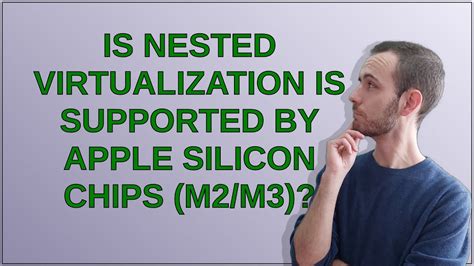In the ever-evolving landscape of technology, Apple’s latest release, macOS 15.0, has captivated the developer community with its groundbreaking support for nested virtualization on the new M3 chips. While this marks a significant leap for macOS users, it brings to light a broader discussion about platform control and market segmentation. The implications of this feature resonate far beyond the technical realm and delve into how technology governance shapes user experiences and choices.
One of the principal benefits of nested virtualization is the potential for more powerful and versatile virtual environments. For developers, this means being able to run a full suite of virtual machines (VMs) within a single host environment, streamlining development and testing processes. Consider a scenario where a developer needs to test a new macOS feature within a virtualized environment that itself resides within another VM. This levels up the capability to isolate environments, ensuring better resource management and security. Notably, services such as GitHub Actions can now run more efficiently on Apple Silicon, addressing previous limitations of virtualization on this platform.
However, the excitement surrounding macOS’s new capabilities contrasts sharply with the absence of similar support in iPadOS. User comments and community engagement reveal a critical understanding of why Apple is unlikely to extend these features to its mobile operating systems. Apple has consistently segmented its market by drawing clear lines between its products. As mentioned by users, this deliberate strategy involves enabling or disabling particular features based on the device to drive users towards higher-end products. In this context, nested virtualization becomes a premium feature of macOS, enhancing its appeal to professional developers while leaving iPad users within a more controlled, albeit limited, environment.
This decision by Apple is intricately tied to broader industry practices and philosophies regarding platform control and user freedom. While some argue that virtualization enables users to run software outside Apple’s purview, potentially compromising security and monetization opportunities, others highlight user autonomy as a fundamental right. Users like _nalply point out that Apple’s stringent control is primarily about controlling what users can run on their devices, which is evident in the tight restrictions on iPadOS. This strategy contrasts sharply with other major operating systems, such as Windows, which maintain fewer barriers to running custom or third-party code. For instance, while Windows Home might not ship with Hyper-V, it doesn’t obstruct users from utilizing other hypervisors like VirtualBox.
Moreover, the implications of software regulation extend into the realms of device longevity and electronic waste. Discussions among users draw attention to the potential for older Apple devices to continue functioning efficaciously if they could run alternative operating systems like Linux. Swapping iPadOS for a light Linux distribution could repurpose outdated devices for various single-function tasks, transforming potential e-waste into useful technology. Despite the clear eco-friendly benefits, Apple’s ecosystem largely remains closed, rendering their devices practically obsolete once official support ends. The community’s sentiment seems to resonate with the idea that user freedom to customize their devices could significantly mitigate e-waste, aligning with pressing environmental concerns.
Yet, it’s important to recognize that Apple’s approach is not wholly without merit. The strong integration of hardware and software within a controlled ecosystem allows Apple to deliver highly optimized and reliable user experiences, unparalleled in the tech industry. Security and performance are hallmarks of Apple’s products, often cited as critical advantages of its walled garden approach. This overarching control simplifies the user experience, reduces the risk of malware, and ensures seamless updates and support across devices.
In conclusion, macOS 15.0’s support for nested virtualization on M3 chips represents more than just a technical enhancement; it marks a strategic move by Apple to solidify its position in the professional market while maintaining its tight grip on broader consumer segments. The debates and discussions it has sparked highlight ongoing tensions between platform control and user freedom, as well as the environmental impact of closed ecosystems. As technology continues to evolve, these conversations will undoubtedly influence future developments and policies, shaping the tech world for years to come. For now, macOS users can revel in the enhanced capabilities while the rest of the Apple ecosystem watches closely, contemplating the broader implications.


Leave a Reply